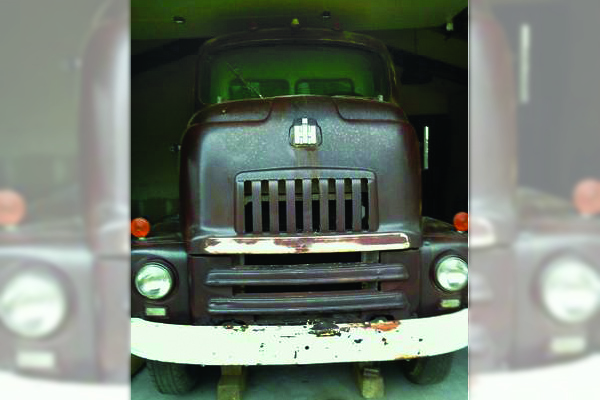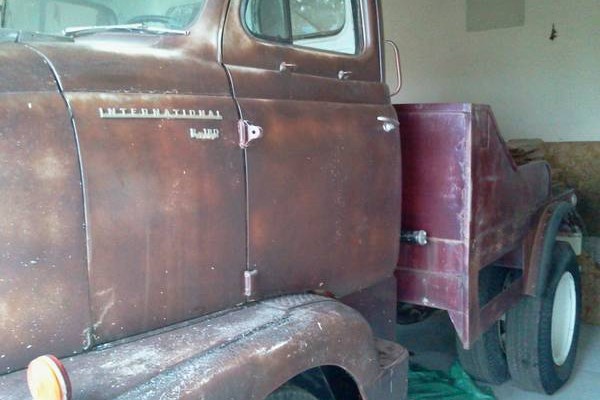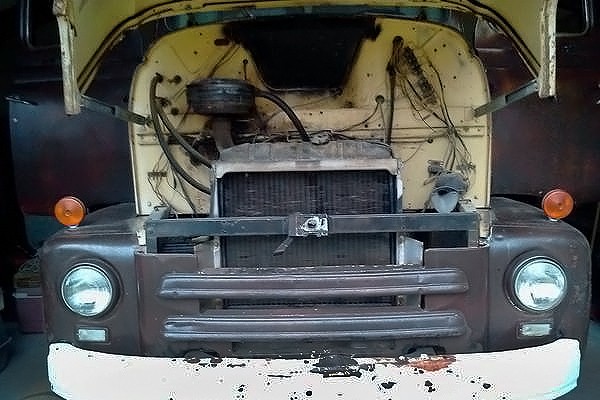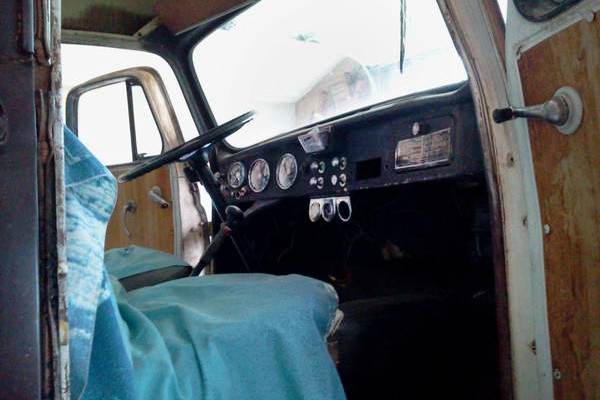The word “cool” doesn’t even come close to describing this unique truck. This 1955 International Harvester R180, found on Craigslist in Casper, WY is one cool COE. The seller is asking $4,500 for this cool cab-over.
COE (cab-over-engine) trucks are pretty hot right now and this example seems like a reasonable project for someone to get back into shape and on the road again. These pug-nosed trucks are popular with car-haulers, at least ones with reality television shows. I can see why; they’re so unique that they really catch your eye when you see one on the street. It would make a great truck if a person has a service business; it would be instant advertising.
I’m not sure if Wyoming uses salt on their roads or not, but if they do this truck must not have been driven too often in the winter. The seller doesn’t mention anything about rust and it doesn’t look like it’s in the kind of rough shape that I would expect for a 61-year old work truck. That little box on the back almost looks like it was used for pulling a 5th-wheel trailer or something, but there is no mention of that. The photos show a spare tire, a battery, and some lumber piled up in the back but there aren’t any detail photos included.
This truck has obviously been painted brown from what may have been the original color of yellow or cream, but you’ll want to paint it your own colors anyway and add your business logo all over it, so that shouldn’t be a problem. The seller says that the truck “ran when parked” not long ago, but unless it’s just a dead battery and they didn’t try changing it, I don’t know why it wouldn’t run again now. From what I’ve heard, these cab-over trucks weren’t as easy to work on as a truck with a regular cab. These partial cab-overs aren’t as bad as a true cab-over, where you have to tilt the whole cab forward to service the engine. The “BBC” ratio – bumper-back of cab measurement – is less on a cab-over because this style of truck has the cab partially over the engine. They tend to ride a little rougher and bumpier because of the shorter wheelbase. Some jurisdictions charge by the length of a truck, so cab-overs were a way to get around those fees a little bit.
The interior will need some updating as you can see, but you’ll probably want to bring the whole truck back anyway. The commanding driving position on these trucks really gives a good view out over the road, making them a bit safer for seeing things but maybe not as safe in frontal crashes. Let’s hope that never happens with this cool truck! I think that this would be a fun way to promote a business while having a super unique ride at the same time. What do you think of this cool cab-over?







How’d you like to climb into this every morning? Great find. ( being a little vain, Scotty did this just for me) Cab overs are a love/hate thing. I’ve spent a fair amount of time in a cab-over, and I love to hate them. Some drivers liked them. They did have some advantages over a “conventional” truck, but I never cared for them. Hot, noisy, hard to work on, goofy driving position ( you could always tell someone not familiar with a cab-over, as their right wheels would be on the shoulder). This truck appears to be a road tractor converted to possibly a boat or mobile home toter. In ’55, IH changed the “R” series pickups to the “S” series, but retained the “R” series for the bigger trucks. Probably has the “Black Diamond” engine, 264, 282, or 308, all “big” 6 cylinders, but they made bigger ones. Cool find, however, I must correct the author, while it’s true, cab-overs were introduced to have “less truck” and “more trailer”, over all truck length laws were abolished many years ago, and cab-overs fell out of favor. Again, with “antique”, yet capable powertrain, not sure what you’d do with it, 50 mph is probably all you’d get out of this, but with a modern drivetrain, the possibilities are endless. Thanks, Scotty.
“… over all truck length laws were abolished many years ago… ”
Is this true in all States? In Ontario we still have limits and regulations. It is my experience that our legislated rules nearly always mimic those south of the border.
The laws being abolished might be a little too strong a statement. They were loosened and changed on Federal Highways but many states still regulate them. I passed many semis today on the way back from Salt Lake pulling double 53 foot trailers, with a conventional truck they can easily be 120 feet overall, but they are not allowed in places like California or further than a few miles from the interstate in many jurisdictions. They also require special permits. The more liberal length laws have all but killed the class 8 cabover market. Even most big fleet operators have given them up in favor of conventional cabs.
>over all truck length laws were abolished many years ago
-Thanks for that, Howard A — I thought that COE’s were just about making the road more visible and manueverability. I learned something.
If I still lived out in the country I would be all over this truck, if he’s truthful and it still runs but needs tires and probably other safety items such as brakes it would be a heck of a hauler for local stuff. I like it !!!
On a side note when I did live in the country a cab over 18 wheeler was coming down the highway and right in front of my house where I was doing some yard work he blew a front drivers side tire, scared the living crap out of me, well he was able to get it to the side of the highway a short distance up the road so I hopped in my pickup and went to check on him. When he opened that door a hole as big as a dinner plate was blown threw the front fender well and he had tire dust all over him. Very scary sight but he was OK and they came and replaced the tire and he was off on his way.
Hi JW, I’ve put more than 2.5 million miles in a semi, and thankfully, never had a steer tire let go, but have seen the damage they can do. Power steering has helped avert disaster, as I heard a steer tire blowout with manual steering, it will jerk the steering wheel out of your hands. I can bet the farm ( if I still had one to bet on) this truck does NOT have power steering, like most trucks of this vintage. Power steering didn’t become popular until the early ’70’s, so that’s another consideration with this. ( and believe me, manual steering trucks are a beast to drive)
Howard would it be possible to add a aftermarket power steering unit to the existing motor, say if you wanted to otherwise keep the rest of the truck all original ?
do you have any miles in a gmc cracker box? i received some training from a driver that team drove a cracker box with a single sleeper. thanks
Hi JW and jim,, one at a time, ONE AT A TIME! @ JW, I believe PS could be added to anything. It may require a later model steering box, which would a be welcome addition anyway, and run a pump off the motor.
@ jim s, I never have driven a “Cracker Box”. A tad before my time, but knew “old-timers” that did. They were a challenge to drive, to say the least. In case someone doesn’t know ( kind of a silly name for a truck) the “Crackerbox” ( called that, because their cramped cabs and appearance resembled a box of crackers) was a GMC “F” model cabover from 1959 to 1968, when it was replaced by the Astro, a very nice truck, by cabover standards. http://img01.deviantart.net/b53f/i/2007/241/6/b/crackerbox_gmc_by_426maxwedgie.jpg
Hi guys. If I could join in the conversation, I’d probably go for a power steering assist which is a hydraulic ram with control valve that anchors to the frame on one end and attaches to the drag link. They run a basic high output pump (you do NOT want one of those flimsy light automotive pumps) off the motor usually belt driven. Truck accessory shops or wreckers should be able to supply what you need. They will definitely help save your backside if one of your steer tires has young ones. I might add that a steering assist still lets you ‘feel’ the road whereas full integral power steering units don’t allow you that luxury…
I am getting a picture of this truck, with a full load, creeping up a hill in low gear.
I drove an IH Cargostar with a 24′ box on it for a couple of years in the mountains in San Diego. 5-speed with 2-speed rear end. Was a good truck when I finally figured out the shift pattern. I found that with the IH tranny I had to shift from 4 low to 5 low then to 4 high and 5 high.took me a bit to figure why the RPM jumped when I shifted from 4 hi to 5 lo.
Hi rangeroger. They call that transmission a ‘Short Fourth.’ Go all the way to 5-Low, then 4-High and 5-High. It sure beat splitting the shifts all the way. Our farm trucks were split all the way until we got our ’61 GMC; that was the first one with a short fourth. By the 70s most trucks we sold were Short Fourth, be them Spicer, Clark or New Process.
This is a nice unit. Not especially built for speed but will take you and your cargo anywhere you need to go and bring you back. One thing that bothers me immensely are the number of these that are being sold, then the cabs pulled and dropped onto modern 1-ton chassis to make a super razoo pickup or a cool car hauler. Sure the owner has the right to do what he wants with them and some of them look real good when they’re done but eventually you run out of the originals and wonder what happened to all of them.
A guy I worked with years ago was a driver in the 40’s and he recalled dropping it into low low gear and he could walk beside the truck going uphill.
Sorry, but not as tough as the Duel truck.